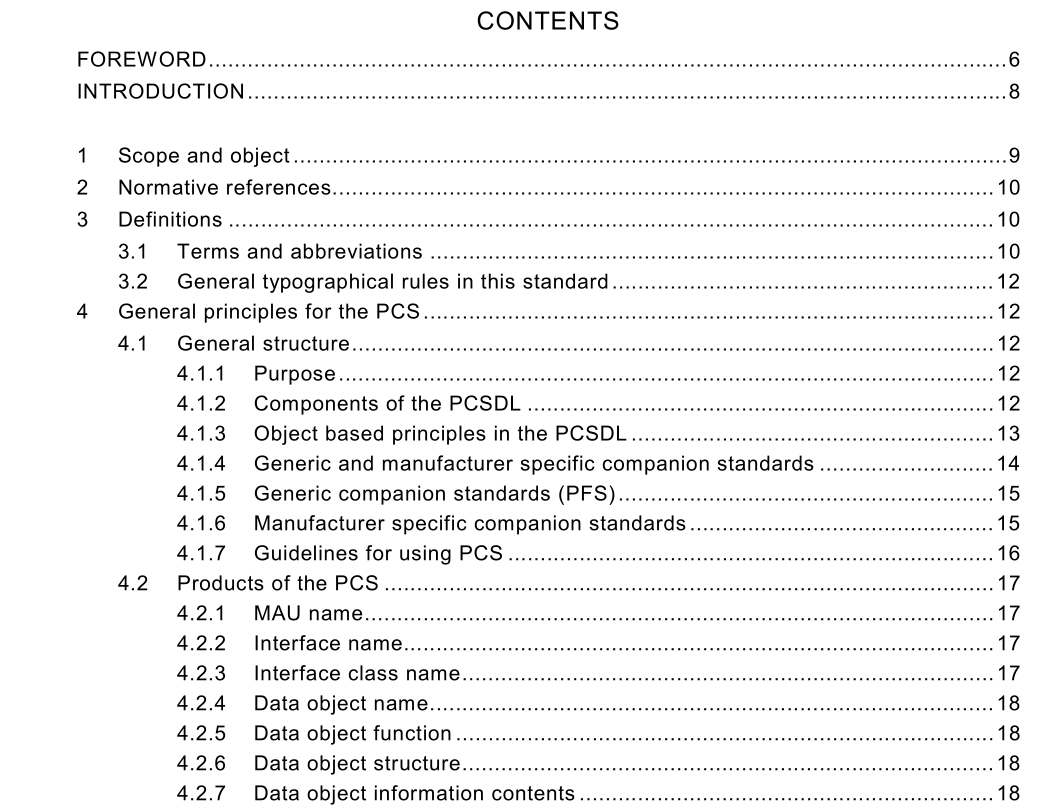IEC 61162-420 pdf download

IEC 61162-420 pdf download.Maritime navigation and radiocommunication equipment and systems – Digital interfaces
1 Scope and object
International Standard IEC 61 1 62-420 specifies the requirement for and basic components of the IEC 61 1 62-4 series companion standards. These components are referred to as follows: a) PCS (PISCES companion standards) which contain the rules for creation of companion standards. The general principles underlying the PCS are described in clause 4. b) PCSDL (PCS description language). Part of the PCS is the definition of the syntax for the various types of companion standard documents that make them readable by computer tools. The PCSDL is described in clause 5. c) function block description. The function block description is a high level and graphical description of applications using the IEC 61 1 62-4 series interface standard. The function block syntax is specified in clause 7. d) PFS (PISCES foundation specifications) which contain a framework for classification of applications adhering to the IEC 61 1 62-4 standard. The PFS will also provide a minimum level of interoperability between different manufacturers’ applications using this framework. The PFS is described in clause 6. Clause 5 contains the complete reference to the PCS description language. Subclause 5.2 explains the basic concept of the PCS which is given by the distinction between four types of specifications: applications, interfaces, information and data types. General conventions with respect to the syntax of the PCS can be found in 5.3. All PCS documents are based on a similar structure. This approach is intended to make it easier to become familiar with the syntax and semantics of the PCS which is defined in 5.3.1 . The four subclauses thereafter explain in detail the syntax and semantics of the four different types of specifications generated by the PCS.Clause 6 describes the relationship between the different classes of IEC 61 1 62-4 applications and gives an overview of their functionality. The annexes contain the detailed PCS definitions for the classes. The objective of companion standards is to provide definitions of the information that is transferred within an integrated ship control system and of how these information items can be accessed or provided. Furthermore, the standard shall allow the definition of the actual network interfaces which the applications use to connect to the system. The description format is machine-readable, allowing an automatic compilation of the description into interface software. A companion standard allows the reader to, at will, shift the focus between a technical specification and a definition of interfaces and information items. The development team can determine information attributes like unit, power, accuracy and the structure of the system architecture and create a common interpretation basis for data before the system implementation. The formalisms underlying the specification language will at the same time provide an unambiguous and precise description of the equipment interfaces which allow the use of computer tools to automatically generate interface program codes or to inspect and manipulate interfaces on-line, for example for debugging and monitoring purposes.
3 Definitions
For the purpose of this part of IEC 61 1 62, the following definitions apply. 3.1 Terms and abbreviations 3.1.1 abstract specification PCS specifications that are part of the PFS (defined in this standard) are not intended for direct implementation and are termed “abstract” 3.1.2 application interface a collection of interface components instantiated in an application definition document as one protocol level interface 3.1 .3 CP – connection point an application interface consists of a number of individual “functions” that can be called into or out from 3.1 .4 CS – companion standard a protocol layer on top of the normal OSI application level (see definition of companion standard in IEC 61 1 62-400), representing the definition of how the application layer functionality is used to implement a certain application’s interface functionality. Also called user layer 3.1 .5 function block a high level, partly graphical representation of an application’s place in an integrated system which presents all interfaces and relationships between these on an overview level 3.1 .6 interface (component) a collection of connection points (CP) in one INTERFACE definition document. It can be aggregated with others into an actual interface as defined in the A-profile. The actual interface (A-profile sense) is defined as the application interface in the APPLICATION document 3.1 .7 NMEA the National Marine Electronics Association (NMEA) maintains a protocol standard called NMEA 01 83 that is almost identical to IEC 61 1 62-1 and IEC 61 1 62-2. For historical reasons, symbolic names in some of the PCS documents in this standard refers to NMEA instead of to IEC 61 1 62-1 (annex F). Although references to NMEA are made, the PCS documents define an application that is intended for use together with the IEC 61 1 62-1 and IEC 61 1 62-2 standards. It can also be useful for transmittal of NMEA 01 83 messages, but this is outside the scope of this standard.









